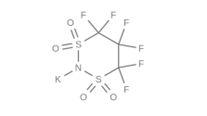INTRODUCTION
Commonly known as potassium bis(fluorosulfonyl)imide (KFSI), the compound has a three-carbon backbone bearing six fluorine atoms and two sulfonimide (-SO₂F) groups. The molecule’s architecture lends it both high chemical stability and useful reactivity. Because of its excellent ionic conductivity and thermal / electrochemical stability, it finds use in advanced electrolyte formulations—for example in lithium-ion and next-generation batteries, in ionic liquids, and in other electrochemical systems.
Manufacture
The synthesis consists of six steps, beginning with a nickel-catalyzed ring opening and di-iodination of 2,2,3-trifluoro-3-(trifluoromethyl)oxirane, followed sequentially by di-sulfonation, di-chlorination, di-fluorination, cyclic amide formation, and finally conversion to the potassium salt through treatment of 1,3-dihydroperfluoropropane bisulfonimide ammonium salt with potassium tert-butoxide.
| Synonyms | Potassium;4,4,5,5,6,6-hexafluoro-1λ6,3λ6-dithia-2-azanidacyclohexane 1,1,3,3-tetraoxide |
| CAS no. | 588668-97-7 |
| EINECS no. | 224-335-9 |
| Molecular formula | C₃F₆KNO₄S₂ |
| Molecular weight | 331.24 g/mol |
| Structure |  |
Applications
KFSI is a highly specialized compound known for its unique properties and versatility in various applications
| Electrolyte in Batteries: |
| It serves as an effective electrolyte salt in lithium-ion & potassium ion systems, enhancing their performance and longevity. Its excellent thermal stability and electrochemical properties make it an ideal choice for energy storage systems, particularly in high-performance applications such as electric vehicles and renewable energy storage. |
| In Photoresists / Microelectronics: |
| Component in photoacid generators, supporting microfabrication and lithography processes. |
| Solid Polymer Electrolyte: |
| When blended with polymers, it boosts thermal stability and enables the creation of advanced fluorinated materials and specialty chemicals, essential to next-generation electronics and aerospace solutions. |
| Fluorinated Surfactants: |
| Used in the formulation of fluorinated surfactants, which are valuable in various cleaning products and coatings due to their excellent wetting properties and resistance to dirt and stains. |
| In preparation of graphite intercalation compounds (GICs) containing the cyclo hexafluoropropane-1,3-bis(sulfonyl)amide anion. |
SPECIFICATIONS
| Test | Unit | Specification |
|---|---|---|
| Appearance | – | White to almost white powder |
| Water Content | % | Max 1.0 |
| Purity | % Area | Min 95.0 |
STORAGE & PRECAUTION
Store at ambient conditions
PACKING
Compliant with international regulations
REACH Status
Not registered
ExSyn offers 1,1,2,2,3,3-Hexafluoropropane-1,3-disulfonimide Potassium Salt on commercial scales and welcomes enquiries. No matter the quantity you need, our exceptional quality and service will make ExSyn your supplier of choice! If you need any additional information or SDS, please contact us.
5-Methyl-3-vinyl-2-oxazolidinone (V-MOX) is a highly reactive monomer valued for its low viscosity, mild odor, and excellent reactivity. It is widely used as a reactive diluent in UV-curable inks and coatings, where it enhances adhesion, produces brighter colors, and improves safety compared to conventional diluents. In addition, V-MOX serves as a key building block in the synthesis of kinetic hydrate inhibitor (KHI) polymers, which are applied in oil and gas production to prevent hydrate blockages in pipelines.
Zinc ricinoleate is the zinc salt of ricinoleic acid, a hydroxylated fatty acid derived mainly from castor oil (Ricinus communis). It appears as a white to slightly yellowish powder, waxy solid, or paste, depending on formulation. Its most valuable property is its ability to trap and absorb odor molecules such as amines, sulfides, and short-chain fatty acids, making it an essential ingredient in deodorant and odor-control products.
2-(tert-Butyl amino)ethyl methacrylate (TBAEMA) is a functional methacrylate monomer that contains a secondary amine group and a hydrophobic tert-butyl moiety, giving it excellent versatility in pH-responsive and adhesion-enhancing polymer systems.
It is valued in printing ink formulations for its ability to enhance adhesion, flexibility, and surface interaction.
Colchicine is a naturally occurring alkaloid obtained primarily from the autumn crocus (Colchicum autumnale) and related species. It has been used in medicine for centuries, especially for the treatment of gout and Familial Mediterranean Fever. In modern medicine, Colchicine is valued also in conditions like pericarditis, Behçet’s disease, and certain dermatological and cardiac disorders.
1-Butylimidazole is a versatile organic heterocyclic compound belonging to the imidazole family, where a butyl group (–CH₂–CH₂–CH₂–CH₃) is attached to the nitrogen atom at the 1-position of the imidazole ring. Its applications span organic synthesis, materials science, and bioactive compound development due to its tunable physicochemical properties and structural versatility.
Atropine sulfate monohydrate is a chemical compound, specifically a salt of atropine and sulfuric acid, with one water molecule (monohydrate) attached. It is commonly used as a medication and in research due to its anticholinergic properties, meaning it blocks the effects of acetylcholine at muscarinic receptors.
4-Aminobenzoic acid, commonly abbreviated as PABA, is an aromatic amine and carboxylic acid compound. It consists of a benzene ring substituted with an amino group (–NH₂) in the para position to a carboxylic acid group (–COOH).
2-Amino-5-Nitrophenol (5-NAP) is an organic compound with the molecular formula C₆H₆N₂O₃. It is a substituted phenol with both an amino group (-NH₂) and a nitro group (-NO₂) attached to a benzene ring, along with a hydroxyl group (-OH).
Pongamol is a naturally occurring flavonoid primarily extracted from the seeds and leaves of the Pongamia pinnata tree (also known as Karanja tree), native to South and Southeast Asia. It is a cream-colored compound that belongs to the flavonoid family and is known for its antioxidant, anti-inflammatory, antimicrobial, and pesticidal properties. It is one of the key bioactive constituents of Pongamia oil.
